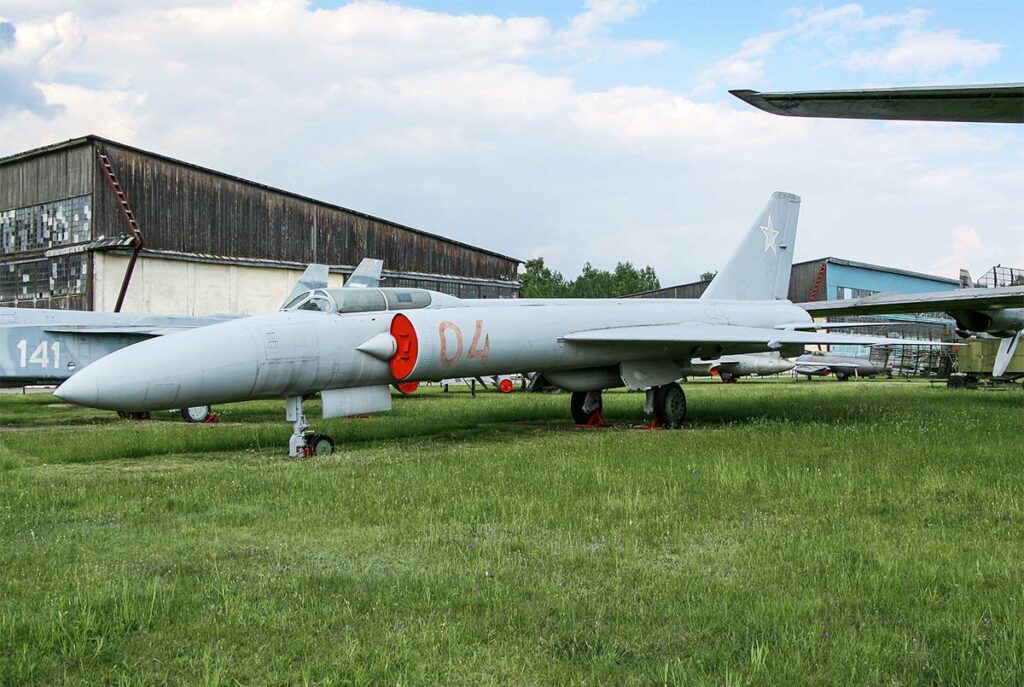The Lavochkin La-250 Anaconda was a Soviet high-altitude interceptor aircraft prototype, known for its elongated body and delta-wing design.
In Brief
The Lavochkin La-250, nicknamed “Anaconda,” was a prototype high-altitude interceptor developed by the Soviet Union in the 1950s. It featured two Lyulka AL-7F turbojet engines, each generating up to 22,045 lbf of thrust with afterburners. The aircraft had a maximum speed of 1,700–1,800 km/h, a service ceiling of 17,000 meters, and a range of 2,000 km. It was designed to carry two air-to-air missiles on underwing pylons. The La-250’s length was 26.8 meters, wingspan 13.9 meters, and height 6.5 meters. The design included a delta wing, a distinctive elongated fuselage, and a semi-recessed missile configuration, with later models featuring missiles on underwing pylons.
The Lavochkin La-250 Anaconda was an ambitious Soviet project to develop a high-altitude interceptor during the Cold War era. It was designed to counter potential threats from high-altitude bombers and reflected the technological advancements and strategic needs of the period.
History of the Development of the Lavochkin La-250 (Anaconda)
The development of the La-250 began in 1952 under the direction of the Lavochkin design bureau. The Soviet government, recognizing the need for a high-altitude interceptor capable of engaging targets at speeds up to Mach 1.18 and altitudes up to 20,000 meters, initiated the development of the La-250 as part of the Kompleks K-15 program. The aircraft was designed to carry Type 275 guided missiles and be guided by ground control with terminal onboard radar. The initial prototypes, flown in 1956, faced issues with the K-15U radar and Klimov VK-9 engines, leading to a redesign with K-15M radar and Lyulka AL-7F engines. The redesigned airframe, La-250A, featured a smaller fuselage and delta wing, with missiles carried on underwing pylons. The program faced numerous challenges, including crashes and equipment failures, and was ultimately canceled in 1959.
Design of the Lavochkin La-250 (Anaconda)
The La-250’s design was characterized by its elongated fuselage and delta wing, which replaced the earlier swept wing of the initial prototypes. The aircraft’s large size and high-altitude capability were significant design features. The La-250A, the final prototype version, had a length of 26.8 meters, wingspan of 13.9 meters, and height of 6.5 meters. It was powered by two Lyulka AL-7F turbojet engines and had a fuel capacity of 8,700 kg internally, with an additional 9,700 kg with drop tanks. The armament configuration included two air-to-air missiles on underwing pylons. The aircraft featured a two-crew cockpit, with a second seat for testing purposes.

Performance of the Lavochkin La-250 (Anaconda)
The La-250’s performance was remarkable for its time, with a maximum speed of 1,700–1,800 km/h and a service ceiling of 17,000 meters. Its range was approximately 2,000 km. The aircraft’s delta-wing design contributed to its high-speed performance, but it faced limitations due to engine and equipment issues. The La-250A’s performance was hindered by the less powerful Lyulka AL-7F engines compared to the initially planned Klimov VK-9 engines.
Variants of the Lavochkin La-250 (Anaconda)
The La-250 program produced only a few prototypes, with the La-250 being the initial version and the La-250A being the revised model with a delta-wing planform. No production models were developed, and the program was canceled before any operational variants could be realized.
Military use and combat of the Lavochkin La-250 (Anaconda)
The La-250 did not see military use or combat, as it remained a prototype and was never operationally fielded. The program’s cancellation in 1959 ended any potential for the La-250 to enter service with the Soviet Air Force.
The Lavochkin La-250 Anaconda was a significant but ultimately unsuccessful attempt by the Soviet Union to develop a high-altitude interceptor during the Cold War. Despite its advanced design and impressive performance targets, the program was plagued by technical issues and canceled before it could achieve operational status. The La-250’s development highlighted the challenges of creating high-performance military aircraft during this era and contributed to the knowledge base that would inform future aircraft designs.
Back to the experimental aircraft section.